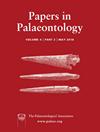Macroalgae from the early Cambrian Chengjiang biota
IF 2.2
2区 地球科学
Q1 PALEONTOLOGY
引用次数: 0
Abstract
The Chengjiang biota, a Burgess Shale‐type Lagerstätte in eastern Yunnan, South China (Cambrian Series 2, Stage 3), provides valuable information regarding the origin and early evolution of metazoans, and complex marine ecosystems. Although the major animal phyla in the Chengjiang biota have been extensively studied, macroalgae have received comparatively little attention. Here, we establish new taxa寒武纪早期澄江生物群中的大型藻类
澄江生物群是位于中国南方云南东部的布尔吉斯页岩型地层(寒武纪第 2 系第 3 阶段),为研究元古宙的起源和早期演化以及复杂的海洋生态系统提供了宝贵的资料。尽管对澄江生物群中的主要动物门类进行了广泛的研究,但对大型藻类的关注却相对较少。在本文中,我们建立了澄江生物群中以前未报道的新类群云南藻类(Yunnanospirellus typica)和云南藻类(Y. elegans),描述了澄江生物群中以前未报道的 5 属 6 种(Tawuia sp.、Morania fragmenta、Liulingjitaenia alloplecta、Longfengshania stipitata、Lo. spheria 和 Paralongfengshania sicyoides),并阐明了肠藻类(Enteromophites intestinalis)的髓结构。目前记录的大型藻类有 13 属 17 种,在澄江生物群物种多样性中排名第四(仅次于大足纲、多孔纲和栉水母纲)。大型藻类占总丰度的 71.57%,远高于澄江生物群中所有其他动物门类。抚仙螺属是最主要的大型藻类,占所有大型藻类标本的 52.01%。不附着(漂浮、浮游或漂流)的形式占主导地位(8 种附着;9 种不附着)。附着大型藻类的高多样性表明,适应新生代坚硬基质(可能被微生物垫覆盖)的大型藻类群落从埃迪卡拉纪一直持续到寒武纪早期,为这一时期坚硬基质的存在提供了有力证据。与此同时,澄江生物群中不附着大型藻类的大量繁殖表明,其他壁龛中也有丰富的大型藻类。不附着大型藻类可能为元古动物提供了氧气和能量,最终导致了寒武纪早期海洋中上层水柱的生态扩张。
本文章由计算机程序翻译,如有差异,请以英文原文为准。
求助全文
约1分钟内获得全文
求助全文
来源期刊

Papers in Palaeontology
PALEONTOLOGY-
CiteScore
4.50
自引率
4.30%
发文量
55
期刊介绍:
Papers in Palaeontology is the successor to Special Papers in Palaeontology and a journal of the Palaeontological Association (www.palass.org). The journal is devoted to the publication of papers that document the diversity of past life and its distribution in time and space.
Papers in Palaeontology is devoted to the publication of papers that document the diversity of past life and its distribution in time and space. As a sister publication to Palaeontology its focus is on descriptive research, including the descriptions of new taxa, systematic revisions of higher taxa, detailed biostratigraphical and biogeographical documentation, and descriptions of floras and faunas from specific localities or regions. Most contributions are expected to be less than 30 pp long but longer contributions will be considered if the material merits it, including single topic parts.
The journal publishes a wide variety of papers on palaeontological topics covering:
palaeozoology,
palaeobotany,
systematic studies,
palaeoecology,
micropalaeontology,
palaeobiogeography,
functional morphology,
stratigraphy,
taxonomy,
taphonomy,
palaeoenvironmental reconstruction,
palaeoclimate analysis,
biomineralization studies.
 求助内容:
求助内容: 应助结果提醒方式:
应助结果提醒方式:


